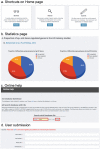HIVed, a knowledgebase for differentially expressed human genes and proteins during HIV infection, replication and latency
- PMID: 28358052
- PMCID: PMC5371986
- DOI: 10.1038/srep45509
HIVed, a knowledgebase for differentially expressed human genes and proteins during HIV infection, replication and latency
Abstract
Measuring the altered gene expression level and identifying differentially expressed genes/proteins during HIV infection, replication and latency is fundamental for broadening our understanding of the mechanisms of HIV infection and T-cell dysfunction. Such studies are crucial for developing effective strategies for virus eradication from the body. Inspired by the availability and enrichment of gene expression data during HIV infection, replication and latency, in this study, we proposed a novel compendium termed HIVed (HIV expression database; http://hivlatency.erc.monash.edu/) that harbours comprehensive functional annotations of proteins, whose genes have been shown to be dysregulated during HIV infection, replication and latency using different experimental designs and measurements. We manually curated a variety of third-party databases for structural and functional annotations of the protein entries in HIVed. With the goal of benefiting HIV related research, we collected a number of biological annotations for all the entries in HIVed besides their expression profile, including basic protein information, Gene Ontology terms, secondary structure, HIV-1 interaction and pathway information. We hope this comprehensive protein-centric knowledgebase can bridge the gap between the understanding of differentially expressed genes and the functions of their protein products, facilitating the generation of novel hypotheses and treatment strategies to fight against the HIV pandemic.
Conflict of interest statement
The authors declare no competing financial interests.
Figures





Similar articles
-
HIV Replication and Latency in a Humanized NSG Mouse Model during Suppressive Oral Combinational Antiretroviral Therapy.J Virol. 2018 Mar 14;92(7):e02118-17. doi: 10.1128/JVI.02118-17. Print 2018 Apr 1. J Virol. 2018. PMID: 29343582 Free PMC article.
-
Identification of novel genes associated with HIV-1 latency by analysis of histone modifications.Hum Genomics. 2017 May 12;11(1):9. doi: 10.1186/s40246-017-0105-7. Hum Genomics. 2017. PMID: 28499422 Free PMC article.
-
Molecular mechanisms for the regulation of HIV replication, persistence and latency.AIDS. 1997;11 Suppl A:S25-33. AIDS. 1997. PMID: 9451963 Review. No abstract available.
-
HIV-1 latency and virus production from unintegrated genomes following direct infection of resting CD4 T cells.Retrovirology. 2016 Jan 5;13:1. doi: 10.1186/s12977-015-0234-9. Retrovirology. 2016. PMID: 26728316 Free PMC article.
-
Reservoirs for HIV-1: mechanisms for viral persistence in the presence of antiviral immune responses and antiretroviral therapy.Annu Rev Immunol. 2000;18:665-708. doi: 10.1146/annurev.immunol.18.1.665. Annu Rev Immunol. 2000. PMID: 10837072 Review.
Cited by
-
Gene Expression: the Key to Understanding HIV-1 Infection?Microbiol Mol Biol Rev. 2020 May 13;84(2):e00080-19. doi: 10.1128/MMBR.00080-19. Print 2020 May 20. Microbiol Mol Biol Rev. 2020. PMID: 32404327 Free PMC article. Review.
-
HIHISIV: a database of gene expression in HIV and SIV host immune response.BMC Bioinformatics. 2024 Mar 22;25(1):125. doi: 10.1186/s12859-024-05740-7. BMC Bioinformatics. 2024. PMID: 38519883 Free PMC article.
-
Network-Based Analysis of OMICs Data to Understand the HIV-Host Interaction.Front Microbiol. 2020 Jun 17;11:1314. doi: 10.3389/fmicb.2020.01314. eCollection 2020. Front Microbiol. 2020. PMID: 32625189 Free PMC article. Review.
References
Publication types
MeSH terms
LinkOut - more resources
Full Text Sources
Other Literature Sources
Medical
Miscellaneous

